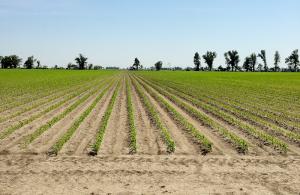Farmer Jim Stuever of Dexter, Mo., has wrapped up planting corn for the year, getting in all the acres he intended in a reasonable time frame. “While we could call this an interesting spring, every spring is interesting,” said Stuever, who began farming in the mid-1970s. “Every year is different, and while some may be similar they are not alike.”
The fits and starts of corn planting nationwide this spring was the opposite of last year’s record pace. Yet planting progress made a major turnaround in the week leading up to the May 19 crop progress report issued by the U.S. Department of Agriculture. During that seven-day period, U.S. farmers planted a record 41.8 million acres (17 million hectares) of corn, or 43 percent of the 97.3 million acres (39.4 million hectares) USDA estimated would be planted this year. That brought the total planted to 71 percent nationwide, just 8 points behind the five-year average.
On a state-level, Iowa farmers planted 8.0 million acres (3.2 million hectares), or 56 percent of the 14.2 million acres (5.7 million hectares) USDA forecast during the seven days leading up to the May 19 report. Illinois farmers planted 7.0 million (2.8 million), or 57 percent of the 12.2 million acres (4.9 million hectares) forecast by USDA. In Missouri where Stuever lives, farmers planted 1.4 million acres (0.6 million), or 42 percent of the 3.4 million acres (1.4 million hectares) forecast to be planted.
“The pace of planting during the week was pretty impressive,” said Erick Erickson, director of global strategies for the U.S. Grains Council. “It shows we had great weather that allowed farmers to get into the field. And the technology that that enables farmers to make that kind of progress is pretty impressive.”
While there are fewer farmers today than two decades ago planting more acres, the size of equipment and the capability of that equipment has helped make up the difference. “When I started farming, I had a four-row planter,” Stuever said. “Now I have a 12-row planter, but many farmers here have 18- or 24-row planters, and some in the main Corn Belt region go even larger.”
Plus, there are a number of little things that make a difference, he said. For example, the seed bins on planters are larger, meaning there are fewer stops during the day, and bulk seed delivery versus bags reduces time spent filling planter bins. Farmers also have a faster ground speed when planting, Stuever said, increasing from 3-4 miles per hour a couple decades ago to 5.5-6.0 mph or more now. There’s also the adoption of minimum- and no-till practices, which reduces the need for soil preparation, and the adoption of auto-steer and GPS technology that reduces fatigue and extends planting time while allowing farmers to more precisely use fertilizer.
“It’s all pretty astounding, really, when you think of the engineering and technology improvements that allow fewer farmers to plant more acres in a relatively short window,” Stuever said. “It gives us the opportunity to get the crop planted and in a good position for strong yields.”
While the quick planting pace eased concerns about yield potential, Erickson said the key months of June, July and August are ahead. “Getting the crop planted is an important first step. Now weather in the coming months is the next critical factor to watch. “



